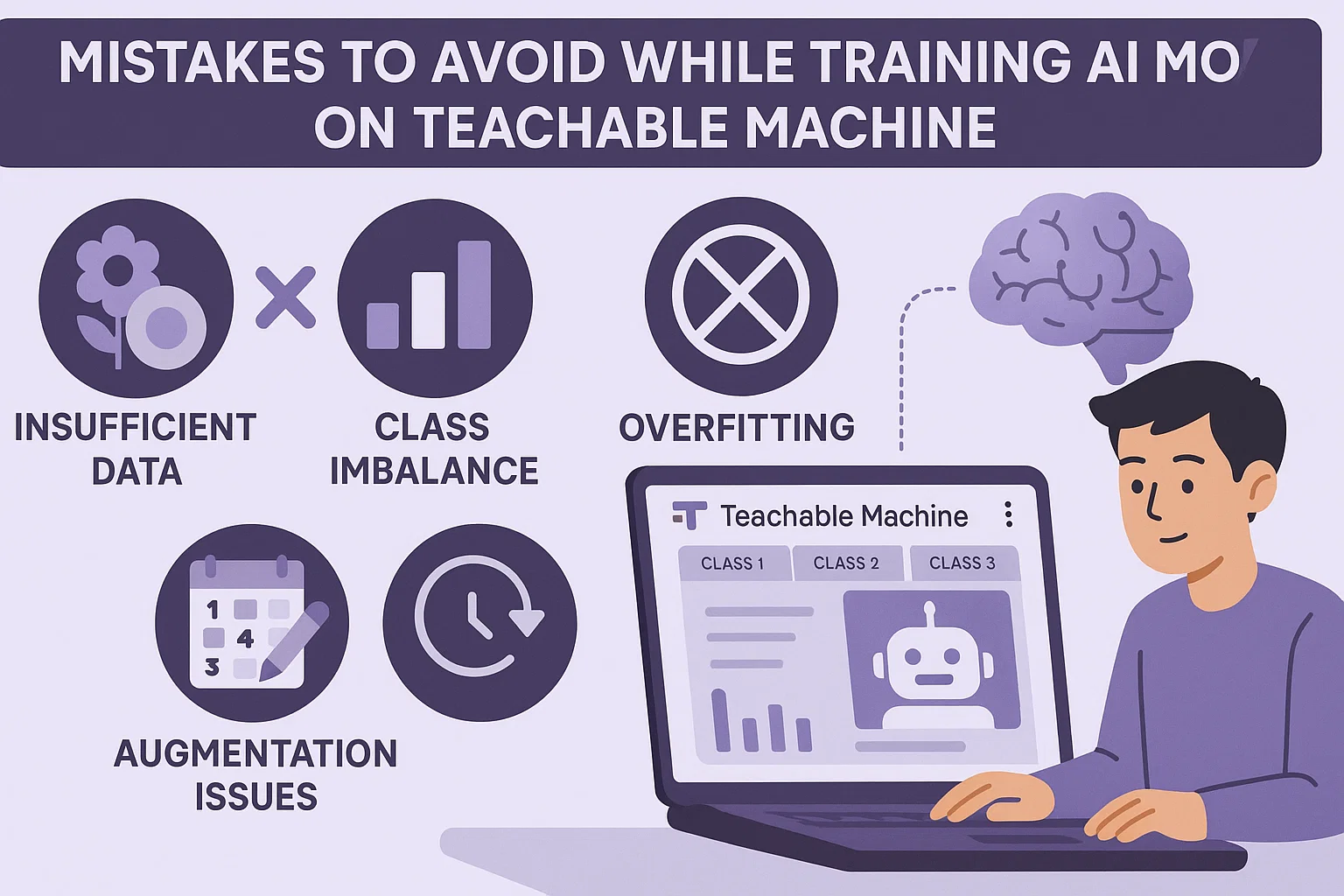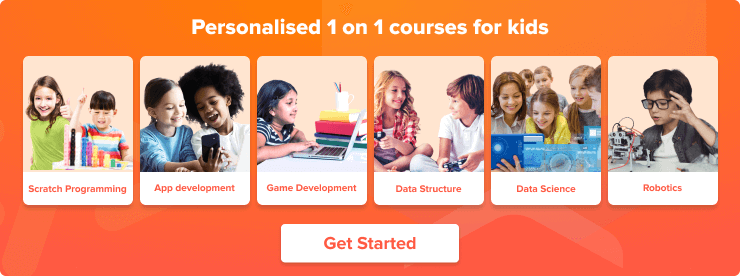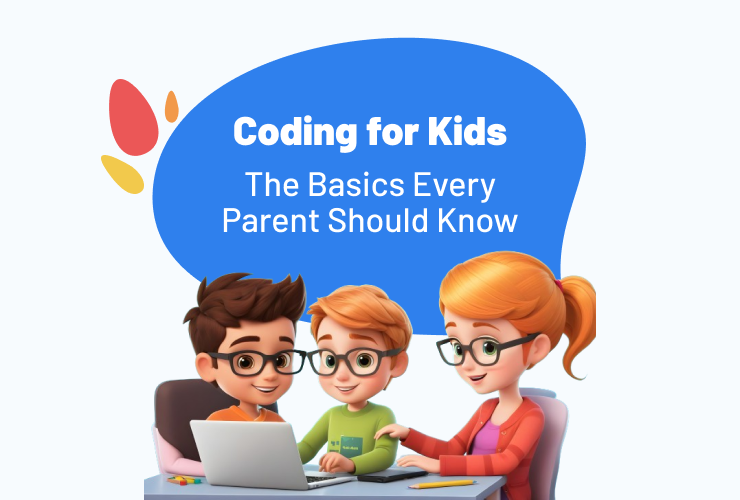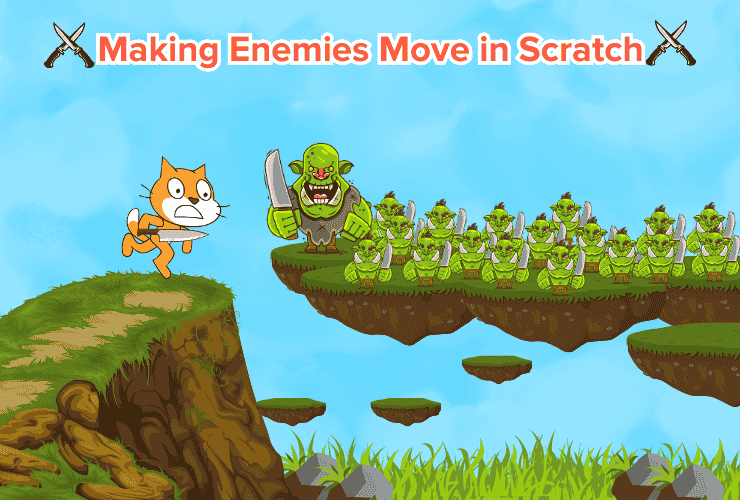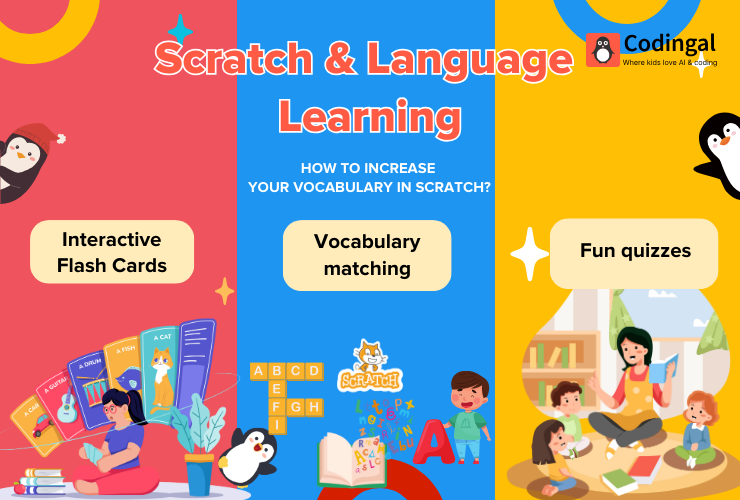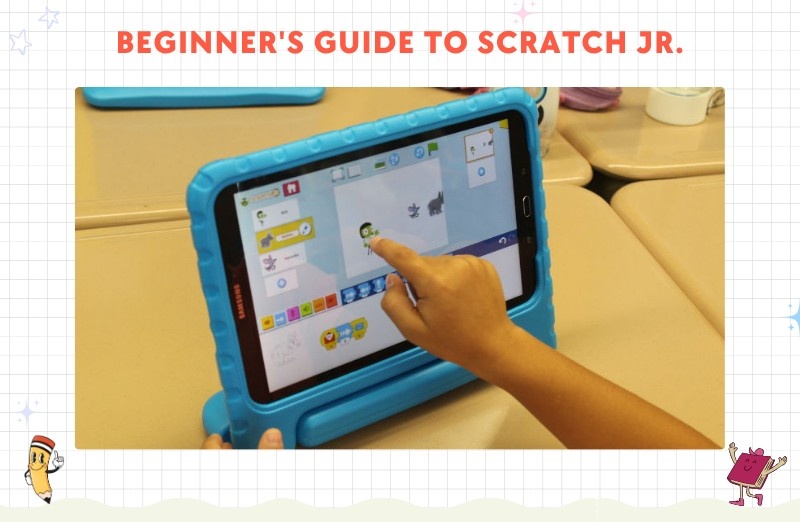Introduction
Artificial Intelligence (AI) isn’t just something we see in movies anymore, it is a part of our everyday lives. From voice assistants like Alexa and Siri to facial recognition on smartphones, AI powers the world around us.
Now imagine giving kids the power to create their own mini-AI systems! That’s exactly what Google’s Teachable Machine allows them to do. It is a simple, fun, and interactive platform where students can train computers to recognize images, sounds, and body poses, all in just a few minutes.
But here’s the catch, just like baking a cake, the result depends on the recipe.
If the “ingredients” (data) or “steps” (training process) aren’t right, the AI won’t work as expected.
To help your child build smarter, more accurate models, let’s explore the top mistakes kids make while training AI models on Teachable Machine, and how to avoid them!
1. Using Too Few Training Samples
The Mistake:
Many beginners upload only a handful of images or sounds per category — sometimes as few as 3–5! When this happens, the AI doesn’t have enough information to learn patterns, and it gets easily “confused.”
Example:
If you’re teaching your AI to tell the difference between a cat and a dog, but you only upload 5 cat photos and 5 dog photos, it won’t understand the real difference between them.
The Fix:
Use at least 30–50 diverse samples per class. Capture images in different lighting, backgrounds, and angles. For sound projects, record voices or noises from varied environments and tones. The more diverse the data, the smarter your model becomes!
2. Using Similar or Repetitive Images
The Mistake:
Uploading ten nearly identical selfies won’t make your AI smarter — it’ll make it lazy! When all your data looks the same, the model simply memorizes the pictures rather than learning how to recognize patterns.
Example:
If every picture of your “happy face” class is taken in the same room with the same background and lighting, your AI might associate “happiness” with the color of the wall instead of your expression.
The Fix:
Add variety to your dataset, change backgrounds, poses, facial expressions, and even clothes. Teach the AI that “happiness” means a smiling face, not just a yellow wall or a bright light.
3. Not Balancing the Classes
The Mistake:
AI learns by comparing examples between classes. If one class has hundreds of samples and another only a few, your AI becomes biased — favoring the larger class almost every time.
Example:
If you upload 100 pictures of cats but only 20 pictures of dogs, your AI will start predicting “cat” for nearly everything.
The Fix:
Keep your dataset balanced. Each class should have roughly the same number of samples. Balanced data ensures your AI gives fair and reliable results.
4. Ignoring Background Noise in Audio Projects
The Mistake:
When training sound models, kids often forget that AI “hears” everything — not just the sound they want to teach it. Background noises like fans, cars, or people talking can confuse it.
Example:
If you’re training your AI to recognize a clap, but your recording has birds chirping or music in the background, your model might start recognizing “birdsong” instead of clapping!
The Fix:
Record in a quiet environment. Use a headset microphone or move to a quiet corner of the room. Keep a consistent volume and distance between recordings to improve sound clarity.
5. Not Testing the Model Properly
The Mistake:
Some students train their AI and assume it’s perfect — without ever testing it on new examples. This gives a false sense of success.
Example:
You train an AI to recognize “happy” and “sad” faces using your own photos. It works perfectly for you — but when your friend tries, the model fails to recognize their emotions!
The Fix:
Always test your model with new data that was not used in training. Try different people, backgrounds, and lighting conditions. Testing teaches kids one of the most important lessons in AI: improving through iteration.
6. Forgetting to Save or Export the Model
The Mistake:
After hours of training, kids sometimes close their browsers — and poof! All progress is gone. Teachable Machine doesn’t autosave unless you download or export your project.
Example:
Imagine creating an amazing model that recognizes your pet, only to lose it forever because you didn’t save. 😅
The Fix:
Always export and download your model once training is complete. You can also connect it to Scratch, Pictoblox, or MIT App Inventor for creative extensions — like making your AI-controlled game or app!
7. Not Understanding What the Model Actually Learns
The Mistake:
Kids often think AI “understands” like humans do. When the AI makes a mistake, they get confused or frustrated.
Example:
If a child trains an AI to recognize a “dog,” the model might focus on the grass or collar color — not the dog itself — because that’s what it “sees” most in the training data.
The Fix:
Explain that AI learns from patterns, not meanings. Encourage kids to analyze what their model “saw” or “heard” when making a prediction. This helps build deeper conceptual understanding and curiosity about how machines learn.
8. Mixing Unrelated Data in One Class
The Mistake:
Some kids upload random images — like dogs, trees, and toys — all under one class name. This completely confuses the model.
Example:
If your “Objects” class contains both pencils and clouds, the AI won’t know what to look for, it will mix everything into one unclear concept.
The Fix:
Each class should represent one clear idea. For example, “Happy Face,” “Sad Face,” or “Neutral Face.” If you’re making an image recognition project, stick to related objects in each class to improve clarity and accuracy.
9. Overtraining the Model Without Checking Accuracy
The Mistake:
Beginners sometimes train their models again and again without testing results — thinking more training automatically means better performance. In reality, it can cause overfitting.
Example:
If you keep retraining your “cat vs dog” model on the same images, it will memorize them. When shown a new picture, it won’t recognize it correctly — even if it’s clearly a cat!
The Fix:
After every training round, test your model. If it performs well on new data, stop. If not, add more diverse samples instead of endlessly retraining. The goal is to help the AI understand, not just remember.
10. Skipping the Fun Part: Experimentation!
The Mistake:
Some kids treat AI training like a math problem by focusing only on getting perfect results and forgetting to have fun experimenting.
Example:
They stop once their model works, but miss the chance to explore what happens if they add a new emotion, background, or pose.
The Fix:
Encourage creativity and curiosity! Let kids play with new categories, gestures, or sounds. Try connecting their model to platforms like Scratch, Pictoblox, or MIT App Inventor to make interactive AI projects, like gesture-controlled games or emotion-detecting characters.
Summary Table: Top Mistakes to Avoid While Training AI Models on Teachable Machine
| # | Common Mistake | What Happens | The Fix / Best Practice |
|---|---|---|---|
| 1 | Using Too Few Training Samples | The model doesn’t learn enough and gives inaccurate results. | Use 30–50 diverse samples per class. Capture data in different lighting, angles, and conditions. |
| 2 | Using Similar or Repetitive Images | The AI memorizes patterns instead of learning real differences. | Add variety — change backgrounds, angles, and expressions to teach the model effectively. |
| 3 | Not Balancing the Classes | The model becomes biased toward the class with more samples. | Keep each class balanced with roughly the same number of images or sounds. |
| 4 | Ignoring Background Noise in Audio Projects | Noise confuses the model, leading to poor sound recognition. | Record in a quiet environment and use a microphone for clear, consistent samples. |
| 5 | Not Testing the Model Properly | You won’t know if your model works in real-world situations. | Test with new data not used during training to identify weaknesses and improve accuracy. |
| 6 | Forgetting to Save or Export the Model | All progress is lost if the browser is closed. | Always export and download your model or connect it to Scratch/MIT App Inventor. |
| 7 | Not Understanding What the Model Actually Learns | Kids expect human-like logic and get confused by AI’s decisions. | Explain that AI learns from patterns, not meaning. Encourage students to analyze predictions. |
| 8 | Mixing Unrelated Data in One Class | The AI becomes confused and can’t distinguish between categories. | Use clear, well-defined classes like “happy face” or “sad face,” not random data. |
| 9 | Overtraining Without Checking Accuracy | The AI memorizes data (overfits) and fails on new examples. | Test regularly and retrain only with more diverse data — not endless repetitions. |
| 10 | Skipping the Fun Part — Experimentation! | Kids miss the creative joy of discovering what AI can do. | Encourage experimentation — try new poses, sounds, or integrate with fun coding platforms. 🌈 |
In Conclusion
Teachable Machine makes AI learning accessible, playful, and inspiring — even for young students. But to make the most of it, kids need to understand that training an AI model isn’t just about uploading data; it’s about teaching a computer how to think using examples.
By avoiding these common mistakes, children can build smarter, more reliable AI models that reflect real understanding — not just memorization.
At Codingal, we believe AI education should be hands-on, creative, and empowering. Through our guided projects, kids not only train models but also learn how to test, analyze, and improve them — developing the mindset of a true AI innovator.
💡 Start your child’s AI journey today with Codingal’s Teachable Machine classes — where coding meets creativity, and learning meets imagination! 🚀
